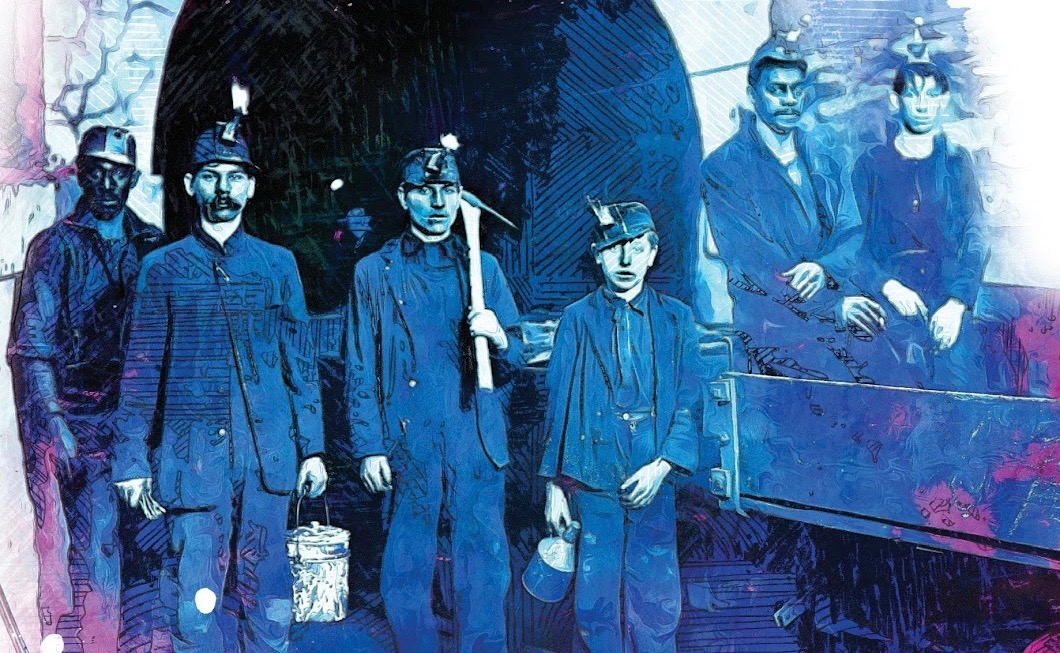A Bloomsbury Press Mine Wars Q&A
By Steve Watkins
[Interview for Bloomsbury Press with Pie & Chai editor Steve Watkins about his new nonfiction book for young readers, The Mine Wars: The Bloody Fight for Workers’ Rights in the West Virginia Coal Fields, published in May 2024.]
What about this story inspired you to make the jump into the nonfiction genre for younger readers?
Some stories are just so compelling that the best thing you can do as a writer is dive into the research, pull it all together, and then get out of the way. Those stories—like the buried history of the West Virginia Coal Mine Wars—practically tell themselves. They just need a publisher with the vision to get them into print.
You yourself once worked in a mine! Can you tell us what that was like?
Hard physical labor, poorly compensated. I did open-pit phosphate mining in Central Florida—it was how I worked my way through college. While I was glad to have the job, it definitely took a physical toll, much more so on the men and women I worked with, many of whom spent their adult lives under the broiling sun day after day, exposed to radon gas and other toxins out in the phosphate fields and back in the processing plant.
Many of the historical figures we meet in this book have outsized personalities. Did you have a favorite?
Definitely Mother Jones, who’s long been one of my heroes. The Irish immigrant suffered unspeakable personal tragedy with the deaths of her four children and her husband to yellow fever when she was still a young mother but went on to devote her life to the labor movement. Once during the West Virginia Mine Wars when a squad of the mine owners’ gunmen had a machine gun trained on a group of striking workers, a then elderly Mother Jones marched up to them and put her hand over the muzzle. One of the gunmen called her a hellcat and threatened to shoot her instead, but she bluffed him out of it by telling him there were 500 armed miners in the hills overlooking the mine ready to start firing—when in fact there weren’t any. The gunmen stood down.
Although the Battle of Blair Mountain was the largest labor uprising in U.S. history, many people today have never even heard about it! Why do you think this history is so important for young readers to learn about today?
America has never given the labor movement nearly enough credit for protecting workers’ rights, negotiating fair compensation, and advocating for safe and humane working conditions. The Mine Workers union and the labor movement in West Virginia coal country are an important part of that story, a chapter that was deliberately hidden for decades by the powers that be in the Mountain State. Mine owners controlled everything—including the history textbooks assigned in schools—for more than a century. The Mine Wars saga is also an exciting story, more riveting than I could possibly have imagined when I started my research, and I have an idea young readers who have never heard of the Matewan Massacre and the Battle of Blair Mountain will be tearing through these pages to find out the true story of what happened, and what happens next.
***
THE MINE WARS REVIEWS
SCHOOL LIBRARY JOURNAL
Starred Review
Watkins tackles narrative nonfiction with a sobering account of the mine wars in Mingo County, WV, in the early 1920s. While mine workers in other parts of the country had successfully unionized with the United Mine Workers of America, those in western West Virginia had been unsuccessful. Watkins begins the book with the story of the Matewan Massacre, as unemployed miners revolted against mine owners and their hired men whose job it was to keep order. “Order” meant firing, attacking, or killing workers who even appeared to sow the seeds of union organization. Subsequent chapters highlight the harsh living and working conditions of the miners and their families, including details of fatal accidents and the practice of child labor. The rest of the book describes the increasingly volatile clashes between the United Mine Workers and mine owners, culminating in the Battle of Blair Mountain in the fall of 1921. Rich in primary source content, this volume has the photographs, maps, and firsthand accounts to give readers a thorough description of the actual coal mining process and the skirmishes between the two parties. Watkins likewise explores the current state of mining. The book is written in language appropriate for young readers and offers definitions of less-familiar terms, but the language is also passionate, demonstrating clear sympathy for the mine workers and union organizers. A complete bibliography and original source citations are appended. Violence is a major part of this work with some descriptions of beatings and killings; librarians and teachers should preview before giving it to younger readers.
VERDICT: A well-researched account of an essential historical account of the U.S. labor movement. Highly recommended for middle school readers and beyond.
KIRKUS
In 1920, a group of West Virginia coal miners, previously fired for being union members, faced off against ruthless enforcers and mine guards. In the battle that followed against the Stone Mountain Coal Company, several men were killed. This was not the first incident in what was a decades-long struggle spearheaded by the United Mine Workers of America to unionize the state’s coalfields. The mine owners and operators had complete control of every aspect of miners’ lives; they had no regard for job safety and used unscrupulous practices to cheat the miners at every turn. The miners were paid in scrip that they could only use at company stores, and rent for company housing was deducted from their pay. They faced poverty, brutality, and political corruption. In this meticulously researched treatise, Watkins compellingly details the struggles for union recognition—as well as violent battles, courtroom dramas, near-victories, and devastating losses—while providing clear, detailed information about people on both sides and using photos, newspaper articles, and quotes to great advantage. The exploration of relationships between white, Black, and European immigrant miners is fascinating; mine owners hoped to “divide and conquer,” but the men who worked together eventually “became friends aboveground,” finding a common cause. Watkins calls out politicians and mining companies for deliberately quashing mention of this history in school curricula and even presenting a false narrative in a book that remains on classroom and library shelves in West Virginia to this day. Fascinating and powerful.
PUBLISHERS WEEKLY
The Great West Virginia Mine Wars of 1920 are unknown to most Americans, according to Watkins (Stolen by Night) in this relevant and enlightening read. Forced to work 10- to 12-hour days in unsafe conditions under the brutal treatment of a violent guard system for credits, or scrip pay only usable at their employer’s store, West Virginia miners attempted to unionize. The mine owners and state government responded by hiring local lawmen and “gun thugs” from Baldwin-Felts Detective Agency, the mine guard company, to union-bust by terrorizing the workers; the gun thugs beat the employees and destroyed their homes, and the owners brought in hundreds of scabs to work the dormant mines. But the striking miners fought back, “igniting the greatest armed insurrection in America since the Civil War,” a yearlong conflict that only ended when federal troops were sent in. In spare and honest text, Watkins explains that the Mine Wars were a part of history that was not just overlooked but intentionally buried by “the powers that be in West Virginia, the coal owners and their politicians, [who] ran a deliberate disinformation campaign.” Archival b&w photographs, newspaper clippings, and political cartoons throughout illustrate the miners’ hazardous working conditions, prominent figures, and common sentiments during this period.
BOOKLIST
Watkins takes readers into the mountains of southern West Virginia for a gritty, bloody tour of American history that’s absent from most students’ textbooks. Despite having dangerous jobs that put ridiculous amounts of wealth in others’ pockets, twentieth-century mine workers were poorly paid for their labor. The United Mine Workers of America (UMWA) sought to protect miners’ rights to fair pay and safer working conditions, but anyone who joined the union could be (and usually was) fired and evicted from their company-owned home. Watkins introduces major players in what would become a series of armed uprisings—namely, the Matewan Massacre and the Battle of Blair Mountain—in 1920 and 1921 between blue-collar miners and the coal industry’s powerful leaders. Watkins, whose sympathies are plainly with the miners, points out the rampant corruption among West Virginia’s politicians and law enforcement, as well as the disinformation campaign launched to keep coal’s reputation shiny. Archival photos and source notes add to the value of this compelling resource, which would make for interesting discussions in relation to climate change and the January 6th insurrection.
BULLETIN FOR THE CENTER FOR CHILDREN’S BOOKS
The coal miners of West Virginia in 1920 and 1921 had moderate requests: safer conditions, higher pay that was in cash instead of company store scrip, and more humane treatment. Even those were far too egregious for the owners, however, and brutal attempts to stop unionization led to a desperate uprising after all other efforts had been thwarted via firing anyone who had signed any union paperwork, as well as threats, bribery, bringing in strikebreakers, and violence. Watkins builds significant tension in the story, emphasizing the increasing exhaustion of the mine workers in truly awful work scenarios, introducing key union organizers and representatives, and identifying mine owners and spies that would be important figures in the eventual uprising, the 1921 Battle of Blair Mountain. Stark, unforgettable photographs are interspersed through the book, including work areas just a few feet tall and propped up by an alarmingly small number of wood posts, groups of young children, who are covered in coal dust, coming out from work, and Eleanor Roosevelt, years after the events of this book, riding through an ostentatiously clean mine. Readers will likely never have heard of this piece of union history—the telling of it for a teen audience is long overdue, and it is unfortunate that it remains sharply relevant today.
***
Steve Watkins is co-founder and editor of PIE & CHAI, a professor emeritus of English, a longtime tree steward with Tree Fredericksburg, an inveterate dog walker, a recovering yoga teacher and co-founder of two yoga businesses, father of four daughters, grandfather of four grandsons, and author of 15 books, two of which are forthcoming in 2024. His author website is http://www.stevewatkinsbooks.com/.


